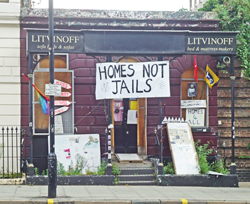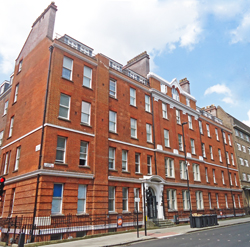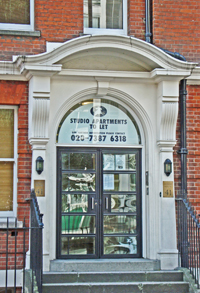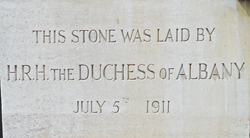Ophthalmic Hospital
Specialist
In 1848 the Institution moved to No. 238a Grays Inn Road, where it was renamed the Central London Ophthalmic Hospital. It had 12 beds.
Smee, appointed to the consulting staff, was also ophthalmic surgeon to the Bank of England (his father was Chief Accountant there), a post which had been especially created for him in January 1841, when he was aged 22 years. An ophthalmological polymath and a pioneer of artificial intelligence (he was a friend of Charles Babbage), Smee initiated a series of regular lectures at the Hospital, which he later published in 1854 in The Eye in Health and Disease, the second edition of his book Vision in Health and Disease, published in 1847.
By the end of the century the premises had become too cramped (some 26,000 patients were being treated annually) and it was necessary to extend the Hospital. On 29th March 1898 an annexe was formally opened by the Lady Mayoress. The Hospital then had 28 beds. However, it was hoped, as soon as funds permitted, to pull down the old building and build a modern hospital in its place.
A Building Fund was started but, in the event, it proved easier to relocate the Hospital to a new site.
In 1911 the Duchess of Albany laid a foundation stone for a purpose-built hospital in Judd Street. She returned in July 1913 to open the new 5-storey building, which initially had 24 beds in two wards on one floor, with small wards for septic cases. The nursing staff consisted of two Sisters and four probationers. The Out-Patients Department, which had its own operating theatre, was already in use. It had closed in Grays Inn Road on a Saturday and re-opened in Judd Street the following Monday.
Later, as the Hospital became fully equipped, 40 beds were available - one floor of wards for men and one for women.During WW1 beds were placed at the disposal of the War Office for sick and injured servicemen.
In 1921, because of severe financial difficulties, the Hospital Committee was forced to close half the beds.
During WW2 the Hospital joined the Emergency Medical Service. In 1943 it affiliated with the nearby Royal Free Hospital, treating its eye patients and training its students. However, not all the beds could be opened as there was insufficient accommodation for nursing and domestic staff (the 48-hour working week had been put into operation, resulting in an increased number of staff). The cost of salaries and supplies had risen enormously, with many items costing two or three times as much as in 1938.
By September 1943 two large wards had re-opened, giving a bed complement of 31 (20 beds remained closed, but the Hospital also had beds available at Stanmore and at Leatherhead).
In July 1944 the
Hospital suffered damage from a V1 flying bomb, with one ward block
destroyed.
After the war, on 1st January 1947, the Hospital amalgamated with the Royal London Ophthalmic Hospital in Moorfields and the Royal Westminster Ophthalmic Hospital in High Holborn. It became the Central Branch of the Moorfields, Westminster and Central Eye Hospital, which joined the NHS in 1948 as a postgraduate teaching hospital.
The Central Branch closed in 1948 and became the Institute of Ophthalmology, the academic arm of the Hospital.THE INSTITUTE OF OPHTHALMOLOGY
In 1948 the destroyed ward block was rebuilt and the building converted for use as the Institute of Ophthalmology. All the laboratory facilities from the other two hospitals were transferred to the Judd Street building, while 21 new beds were added at the Moorfields Branch and 17 at the Westminster Branch.
The Institute of Ophthalmology was officially opened in November 1948 by the Earl of Rothes, Chairman of the Hospital Management Committee.
The basement of the building contained the kitchen, a cafeteria and the students' sitting room. On the ground floor were administrative offices, research clinics, including a small orthoptic clinic retained for research purposes, and the Department for Clinical Teaching.
On the first floor was the Medical Illustration Department, equipped and staffed for photography, including fundus photography, cinematography and fundus drawing. A suite of rooms was available for more elaborate types of clinical research.
The second floor contained the Library and Museum, as well as offices for the British Journal of Ophthalmology and Ophthalmic Literature and a Lecture Hall which could seat 100 people.
On the third floor were laboratories for morbid histology, bacteriology and allergy.
The remainder of the building was given over to 23 laboratories for research into physiological optics, physiology, electrophysiology, biochemistry and radiography, and technicians' rooms. There was also an operating theatre and five animal rooms.
At its opening, the Institute had 126 postgraduate students and 15 full-time research workers.
During the 1980s and 1990s the Institute gradually relocated to its current site in Bath Street, adjacent to Moorfields Eye Hospital.
Present status (October 2008)
The Grays Inn Road building is now in use as self-contained apartments for Camden Council tenants. (Update: it is due to be auctioned in October 2014 by Barnett Ross).
The Judd Street building is now Albany House, a studio apartment block. (Update: it was recently refurbished by Galliard Homes around 2013).

The Hospital building on the corner of Calthorpe Street and Grays Inn Road. The black terraced building shown on the left was once the annexe, built in 1898. The original entrance to the Hospital was through the single storey building on the right.

The former Hospital entrance (No. 238 Grays Inn Road) became a shop for bed makers Litvinoff & Fawcett, but is now (2014) occupied by squatters.

The second site of the Hospital is on the corner of Tavistock Place and Judd Street.

The main entrance.

The foundation stone laid by the Duchess of Albany on 5th July 1911.
(Author unstated) 1844 Central London Ophthalmic Institution. Morning Chronicle, 1st February, 7.
(Author unstated) 1898 Reflections from a Board Room mirror. Nursing Record and Hospital World, 2nd April, 280.
(Author unstated) 1913 The Central London Ophthalmic Hospital. British Journal of Nursing, 19th July, 54.
(Author unstated) 1914 The war. British Journal of Nursing, 15th August, 146.
(Author unstated) 1921 (untitled) British Journal of Nursing, 12th November, 303.
http://hansard.millbanksystems.com
http://bjo.bmj.com
http://history-computer.com
www.flickr.com
www.geograph.org.uk
www.mrcophth.com
www.ucl.ac.uk (1)
www.ucl.ac.uk (2)
Return to home page